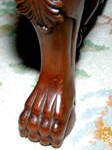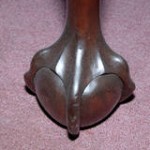In the first part of this brief mini-series about feet, something for which furniture has the upper hand on, we covered a number of different types of furniture feet.
If you missed it, see Furniture Feet – Part 1.
Furniture’s feet can be more than just a design asset. To tenured antique dealers, furniture’s feet can be both a time machine and a map, detailing where exactly the piece came from and the period of its creation.
Today’s piece will center around more ornate and intricately designed feet.

Trifid Foot
As the name suggests, the trifid foot (sometimes referred to as a drake foot) has three grooved markings that run down the length of it. The center groove runs longer than the two beside it, resembling the foot of a duck, hence “drake” foot. This foot was often applied to cabriole legs, which were a part of Queen Anne furniture.

Paw Foot
You guessed it, this style of furniture feet was patterned to resemble the paw of an animal. In most cases, however, it was patterned after the paw of a lion. A creature that was, and still is, revered for its majestic qualities.

Claw-and-Ball Foot
While the names behind these furniture feet may not be all that intriguing, the concepts and inspiration behind some of them can be. This type of foot was carved to symbolize a bird’s talons clasping a ball. The origins of which are from the Chinese tales of dragons protecting the jewels stored in the caves they lived in.
As you can probably see from the forming pattern, many furniture feet were designed after the attributes and features of animals. This is true for some styles of furniture as a whole, not just the feet.
It’s like the saying goes: art imitates life.
